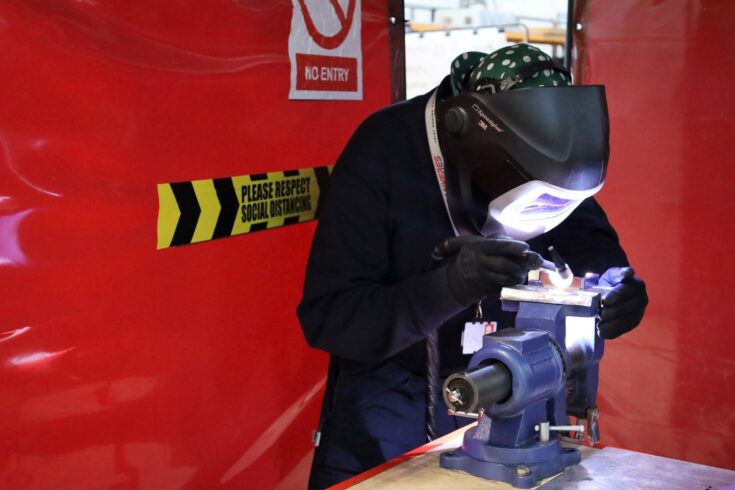Welding might not be the first skill to spring to mind when you think about the Large Hadron Collider (LHC) at CERN, but specialist welding taking place in the STFC Technology Department, will ensure that forthcoming upgrades to LHC will be positively smashing (proton collider pun!).
Coded welding is taking place on cryomodules which are being built in STFC’s Daresbury Laboratory. Precision welds are vital in the building of cryomodules to seal the beam vacuum, insulation vacuum and cryogenic cooling lines. This has been the first coded welding performed at Daresbury Laboratory for many years.
What is coded welding?
Coded welding refers to the welding which meets rigorous industrial standards and can only be undertaken by a qualified welder using particular procedures. In this case, that standard is ISO 15614. It is also innate gas welding which doesn’t use torches and open flames, but uses electric current. These welds have been done by hand, but future welds will be a mixture of hand and an orbital robotic welder which uses a robotic system to weld a seal around tubes of different sizes.
To ensure that welds are fit for purpose, samples will be sent to both CERN and British Engineering Services for qualification. There they will be tested using penetrative dye and microscopy.
Why cavities are acting like crabs!
For the LHC Hi-Luminosity upgrade project (known as Hi-Lumi LHC), the experts at Daresbury Laboratory worked with CERN and other industry partners to develop a cryomodule using a technology called crab cavities. The idea was to rotate bunches of protons within the beam pipe, putting them sideways like crab legs – hence the name. When protons are rotated, it significantly increases the potential number of particle collisions.
When particles collide, they cause a storm of activity and debris which can be measured using detectors. The intensity or brightness of the collisions is known as luminosity, and it is hoped that this project will increase luminosity in the LHC at CERN by a factor of between five and 10. More collisions in the beam pipe means more science to study.
A prototype cryomodule successfully crabbed particles in 2018. Two new crab cavities from an alternative design are now being built into a cryomodule at Daresbury.

The man behind the mask. Welding expert John Hassall takes a break from his work on the cryomodule welding. Credit: STFC
What’s being welded?
Lengths of the accelerator made up of high luminosity crab cavities and beam line, are now being constructed. Five of these modules will be made at Daresbury Laboratory, each with 54 precision welds and every weld with be inspected visually and technically for leaks.
Once they are approved, they will be sealed into an outer jacket which is part of the outer cryomodule which forms an insulated vacuum. More welding of the jacket will follow, then pressure temperature checks as the cryomodules take the cavities down in temperature so that they reach a superconducting state.
Nik Templeton, Senior Project and Mechanical Engineer, is overseeing the Hi-Lumi LHC work at Daresbury Laboratory:
The cryomodule welding is very high spec and complex with almost no margin for error. We made the decision to bring this skill back in-house, with the help of CERN weld engineers.
This is a fantastic achievement for the project team and for us here at STFC Daresbury Lab, as we can use this skill for many more projects in the future.
In all, will take around nine months to build each crab cavity cryomodule – with around half of that time spent in controlled clean room conditions.
Top image: STFC welding expert John Hassall pictured working on the Hi-Lumi welds at Daresbury Laboratory. Credit: STFC



